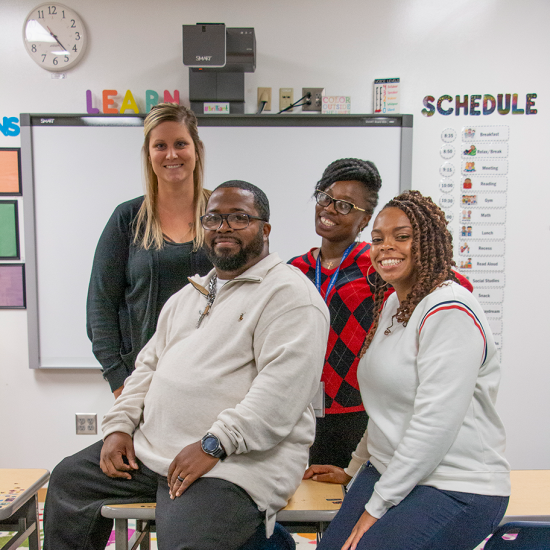Wilder Therapists Join the Classroom
Ashley Gramling had more than the usual first-day jitters when classes started at her school in the Twin Cities suburb of New Hope last year. Ashley, previously a middle school teacher with experience teaching kids with autism, joined an innovative project at her school that brings Wilder therapists into the classroom for elementary school students whose behavior prevents them from joining traditional classrooms.
Ashley had expected to work on academics from the start, but the therapist assigned to her classroom explained that the five first- and second-grade boys in her classroom weren’t ready to learn. “That first week, I drew on the therapist a lot,” Ashley says. “It put me in check to know that as a teacher I had to be OK with letting them just play and that we could do academics at some point. They weren’t ready.”
Instead, Ashley, two education assistants and a Wilder school-based mental health therapist focused on helping the boys understand how to be in school: to sit at a desk and be present for lessons in reading and math, to participate in group activities, and to begin learning to manage their emotions when they feel overwhelmed or threatened.
“We spent a couple months learning how to do school,” Ashley says. “Then we really got into learning. These kids are like sponges. We went from the kids not knowing all the letters of the alphabet to reading and spelling words.” By January, students were joining in a group math game with dice. They worked together by holding up fingers for their friends to count.
Students Are Younger, with Higher Needs
Ashley teaches at the North Education Center, part of Intermediate School District 287, which educates students from 11 West Metro school districts who use a variety of specialized education services not provided in a traditional school setting. North Education Center Principal Tonya Allen says the school began searching for new ideas after children in the school’s program for students with emotional and behavioral disorders started entering at younger ages than before and with more significant needs.
“What we started seeing are students as young as kindergarten with behaviors that mimic two- or three- year-olds, such as tantrums with biting, kicking, spitting, hitting or punching staff,” Tonya says. “If you think about a typical school, those are behaviors you cannot have in a classroom all day long with 20 other students.”
Students who come to the school with emotional and behavioral disorders often have a history of trauma and adverse childhood experiences, abuse, or mental health diagnoses that require more intense interventions than individual therapy sessions. “It’s just one thing after the next, and it’s difficult for a child to function with all that going on around them,” Tonya says.
But there’s hope, say Tonya and others involved with the therapeutic teaching model.
Therapists Are Full-Time Partners in the Classroom
The district approached Wilder Community Mental Health and Wellness to find a new model for helping kids heal. For more than a year, Wilder therapists, teachers and staff collaborated to find a way to give the kids the support they need to learn. With funding from the Minnesota Legislature, they implemented a new therapeutic teaching model during the 2018–19 school year with teams in three classrooms from K–2.
For teachers and education assistants, the biggest change is a Wilder therapist who works full-time in the classroom. A therapist can provide assistance in real time to help students understand and cope with their emotions, and also offers a mental health and trauma-informed perspective to teachers and education assistants.
“In the classroom, we are partners as much as we can be,” says Dr. Benita Amedee, the Wilder clinical supervisor who, with others, helped develop the model and manages Wilder staff at the school. In addition, Wilder therapists offer trainings to teachers and staff and gather with teams regularly for group reflection on how they are interacting with students and each other. “It’s not just the therapist in the room doing the therapeutic work,” Benita says. “Our goal is for the whole classroom to be therapeutic.”
Outside the classroom, Wilder therapists provide individual school-based mental health services to students as well as family therapy. A family resource navigator helps make sure parents have access to the services and support they need.
Classroom Teams See Change in Students
Ashley gets emotional when she talks about her students’ progress. “They’ve had so many doors shut on them already in school. School is supposed to be a safe place to go, but by the time they get here they feel really bad about school already,” she says. “Now that they are here, they’re making friends, they’re sitting at a desk, they’re able to do school. They’re doing so many things and they’re so proud of the day-to-day little things that they are doing. They know what it feels like and looks like.”
Above: Teacher Ashley Gramling, Education Assistant Tyshawn Blackwell, Wilder Therapist Aisaaca Hammond, and Education Assistant Laneka Rogers work as a classroom team in the Therapeutic Teaching Model.
